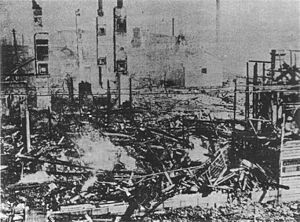Rice riots of 1918 facts for kids
The rice riots of 1918 (also known as kome sōdō in Japanese) were a series of big protests that happened all over Japan. These events took place from July to September in 1918. The riots were so serious that they led to the resignation of the government led by Terauchi Masatake, who was the Prime Minister at the time.
Contents
Why Did the Riots Happen?
Rising Rice Prices
The main reason for the riots was a very sudden increase in the price of rice. Rice was, and still is, a super important food in Japan, especially in the countryside. When its price went up a lot, it made life very hard for many families.
Farmers were especially upset. The government had rules that kept the price they got for their rice low. But at the same time, the price people paid for rice in stores was going way up. This made farmers angry at rice sellers and government officials. They felt these people were letting the prices get out of control.
Inflation and Other Costs
This rise in rice prices was part of a bigger problem called inflation. Inflation means that prices for many things go up over time. In the early 1900s, not just rice, but also other everyday items and even rent became more expensive. This meant that people living in cities were also struggling and had many reasons to be unhappy.
The Siberian Intervention's Impact
Another event that made things worse was the Siberian Intervention. This was when Japan sent its soldiers to a part of Russia. To feed these soldiers overseas, the government bought up a lot of the rice that was available in Japan. This made the price of rice go even higher because there was less of it for everyone else.
The government's actions, like trying to control rice prices but also buying up rice for soldiers, caused the protests to spread. What started in farming areas soon moved to towns and big cities.
What Happened During the Riots?
Protests Across Japan
The rice riots were huge and very intense. Nothing like them had been seen in modern Japanese history before. The first protest began in a small fishing town called Uozu in Toyama Prefecture on July 23, 1918.
At first, people just wanted to peacefully ask the government for help. But things quickly got out of hand. The protests turned into full-blown riots. People went on strike, and some even took things from stores. There were also fires set at police stations and government buildings. There were even fights with weapons.
Scale of the Disturbances
In 1918, there were 417 different protests and arguments involving more than 66,000 workers. The government arrested about 25,000 people. Of those, 8,200 were found guilty of various actions. Their punishments ranged from small fines to very serious ones.
Government Changes
Because of all the public disorder and anger, the Prime Minister, Terauchi Masatake, and his entire government decided to resign. This happened on September 21, 1918. They took responsibility for the chaos.
Long-Term Effects
Some experts discuss whether the riots are connected to Japanese imperialism. They suggest that to meet the demand for rice, which Japan couldn't produce enough of at the time, the country increased rice farming in its colonies. These colonies included Taiwan and Korea.
See also
 In Spanish: Disturbios por el arroz de 1918 para niños
In Spanish: Disturbios por el arroz de 1918 para niños
- List of food riots


